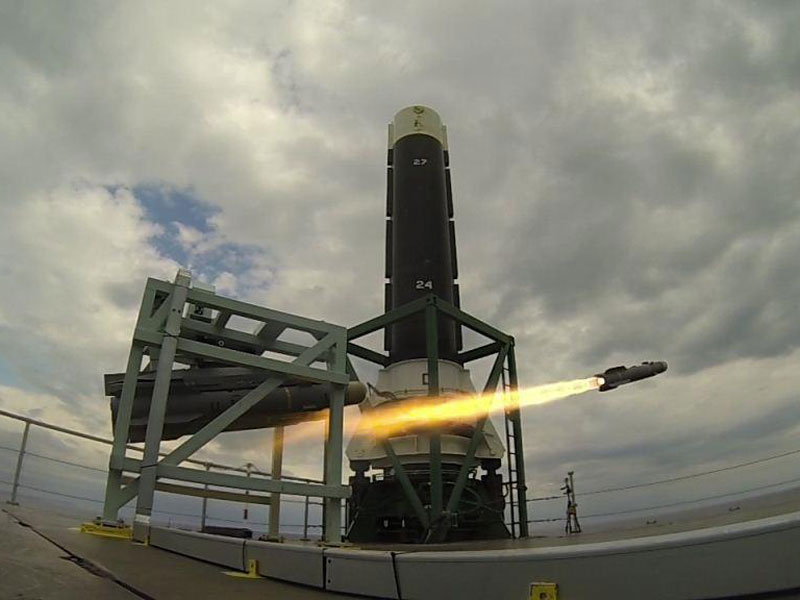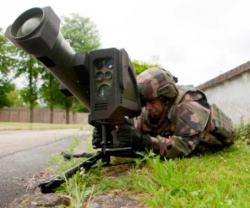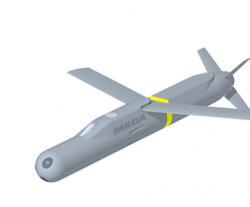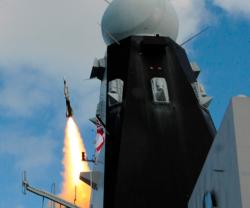MBDA’s Brimstone Missile Destroys Multiple Attack Craft
20.06.2013 North America
MBDA’s combat proven, UK developed, Brimstone missile carried out the world’s first surface to surface salvo engagement of multiple Fast In-shore Attack Craft (FIAC) threats with a single button push. The success of the trial has shown Brimstone’s unrivalled ability to swiftly strike numerous individual vessels without the need to laboriously designate each target, thereby demonstrating its prowess as a fire and forget maritime surface attack weapon.
On the 29th May 2013, three millimetric wave operational Brimstone missiles were launched in a rapid salvo of less than a second against a simulated attack formation of five representative FIACs. The three missiles independently acquired and engaged their respective targets at a distance between 4km and 5km (constrained by range safety); direct hits resulted in extensive structural damage to the three leading vessels, including one travelling at around 20 knots.
The missiles were launched from a surface trials platform using a Brimstone triple rail launcher in conditions of sea state 3.
This exceptional achievement follows on from a previously undisclosed, successful surface launch trial against a single static FIAC on the 6th April 2013. Instead of a warhead the missile carried a telemetry unit to transmit trials data. The missile acquired and identified the target with a subsequent direct hit on the vessel’s control cabin, with the missile passing through the hull at the rear of the craft causing the target to sink.
The Brimstone programme is run by MBDA UK’s team in Stevenage, Hertfordshire while both of these trials were carried out off the west coast of Scotland with range support provided by QinetiQ.
Brimstone is being proposed by MBDA UK as a surface attack missile for deployment within the Sea Spear system against FIACs and other small surface threats in all weather environments. As an effective maritime Force Protection capability, it rapidly provides significant utility beyond the range of medium calibre naval gun systems. With a range of deck-mounted launcher options, from single to six-pack configurations, the system’s very small footprint gives it a high level of deck positioning flexibility making it suitable for small vessels such Fast Attack Craft as well as much larger vessels such as auxiliary ships.
These two separate trials are the continuation of the June 2012 anti-FIAC trial conducted from a RAF Tornado GR4 using a Dual Mode Brimstone (featuring a dual millimetric wave/SAL seeker) that resulted in the sinking of the target. Dual Mode Brimstone has already demonstrated its capabilities as the weapon of choice for precision strikes in a congested environment against a range of fixed and moving ground targets during RAF combat operations in Afghanistan and Libya.
Millimetric wave Brimstone was used operationally during RAF Combat Operations in Libya when it was fired successfully from Tornado GR4 aircraft.
On the 29th May 2013, three millimetric wave operational Brimstone missiles were launched in a rapid salvo of less than a second against a simulated attack formation of five representative FIACs. The three missiles independently acquired and engaged their respective targets at a distance between 4km and 5km (constrained by range safety); direct hits resulted in extensive structural damage to the three leading vessels, including one travelling at around 20 knots.
The missiles were launched from a surface trials platform using a Brimstone triple rail launcher in conditions of sea state 3.
This exceptional achievement follows on from a previously undisclosed, successful surface launch trial against a single static FIAC on the 6th April 2013. Instead of a warhead the missile carried a telemetry unit to transmit trials data. The missile acquired and identified the target with a subsequent direct hit on the vessel’s control cabin, with the missile passing through the hull at the rear of the craft causing the target to sink.
The Brimstone programme is run by MBDA UK’s team in Stevenage, Hertfordshire while both of these trials were carried out off the west coast of Scotland with range support provided by QinetiQ.
Brimstone is being proposed by MBDA UK as a surface attack missile for deployment within the Sea Spear system against FIACs and other small surface threats in all weather environments. As an effective maritime Force Protection capability, it rapidly provides significant utility beyond the range of medium calibre naval gun systems. With a range of deck-mounted launcher options, from single to six-pack configurations, the system’s very small footprint gives it a high level of deck positioning flexibility making it suitable for small vessels such Fast Attack Craft as well as much larger vessels such as auxiliary ships.
These two separate trials are the continuation of the June 2012 anti-FIAC trial conducted from a RAF Tornado GR4 using a Dual Mode Brimstone (featuring a dual millimetric wave/SAL seeker) that resulted in the sinking of the target. Dual Mode Brimstone has already demonstrated its capabilities as the weapon of choice for precision strikes in a congested environment against a range of fixed and moving ground targets during RAF combat operations in Afghanistan and Libya.
Millimetric wave Brimstone was used operationally during RAF Combat Operations in Libya when it was fired successfully from Tornado GR4 aircraft.
Previous PostRaytheon to Keep Enhancing Patriot Capabilities
Latest news
Latest events
DSEI 2025
09 - 12 Sep 2025Excel, London - United KingdomCounter UAS Middle East & Africa 2025
16 - 17 Sep 2025Amman - JordanIntersec Saudi Arabia
29 Sep - 01 Oct 2025Riyadh International Exhibition & Convention Centre - Saudi ArabiaDubai International Air Chiefs’ Conference (DIACC 2025)
16 Nov 2025Atlantis, The Palm Dubai - United Arab Emirates






















